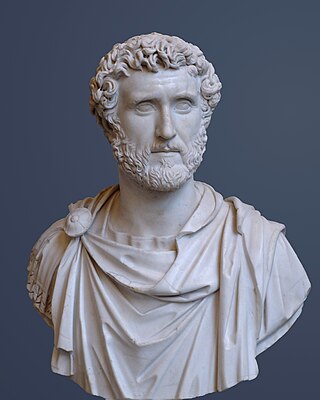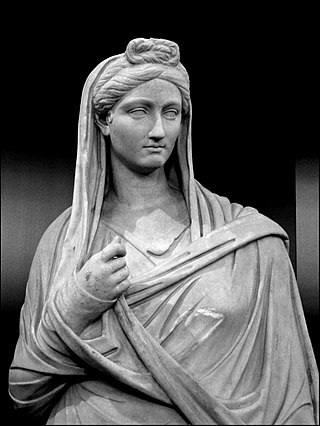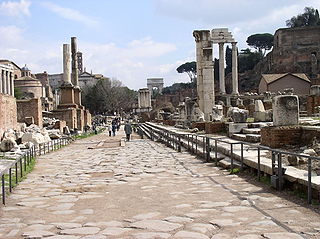
Titus Aelius Hadrianus Antoninus Pius was Roman emperor from AD 138 to 161. He was the fourth of the Five Good Emperors from the Nerva–Antonine dynasty.

Hadrian was Roman emperor from 117 to 138. Hadrian was born in Italica, close to modern Seville in Spain, an Italic settlement in Hispania Baetica; his branch of the Aelia gens, the Aeli Hadriani, came from the town of Hadria in eastern Italy. He was a member of the Nerva-Antonine dynasty.

The 110s was a decade that ran from January 1, AD 110, to December 31, AD 119.
Year 119 (CXIX) was a common year starting on Saturday of the Julian calendar. At the time, it was known as the Year of the Consulship of Hadrianus and Rusticus. The denomination 119 for this year has been used since the early medieval period, when the Anno Domini calendar era became the prevalent method in Europe for naming years.

Antinous, also called Antinoös, was a Greek youth from Bithynia and a favourite and lover of the Roman emperor Hadrian. Following his premature death before his 20th birthday, Antinous was deified on Hadrian's orders, being worshipped in both the Greek East and Latin West, sometimes as a god and sometimes merely as a hero.

In ancient Roman religion Victoria was the deified personification of victory. She first appears during the first Punic War, seemingly as a Romanised re-naming of Nike, the goddess of victory associated with Rome's Greek allies in the Greek mainland and in Magna Graecia. Thereafter she comes to symbolise Rome's eventual hegemony and right to rule. She is a deified abstraction, entitled to a cult. But unlike Nike, she has virtually no mythology of her own.

Annia Galeria Faustina the Elder, sometimes referred to as Faustina I or Faustina Major, was a Roman empress and wife of the Roman emperor Antoninus Pius. The emperor Marcus Aurelius was her nephew and later became her adopted son, along with Emperor Lucius Verus. She died early in the principate of Antoninus Pius, but continued to be prominently commemorated as a diva, posthumously playing a prominent symbolic role during his reign.

Vibia Sabina (83–136/137) was a Roman Empress, wife and second cousin once removed to the Roman Emperor Hadrian. She was the daughter of Matidia and suffect consul Lucius Vibius Sabinus.

Salonia Matidia was the daughter and only child of Ulpia Marciana and wealthy praetor Gaius Salonius Matidius Patruinus. Her maternal uncle was the Roman emperor Trajan. Trajan had no children and treated her like his daughter. Her father died in 78 and Matidia went with her mother to live with Trajan and his wife, Pompeia Plotina.

Ulpia Marciana was the beloved elder sister of Roman Emperor Trajan and grandmother of empress Vibia Sabina the wife of Hadrian. Upon her death, her brother had her deified.

Pompeia Plotina was Roman empress from 98 to 117 as the wife of Trajan. She was renowned for her interest in philosophy, and her virtue, dignity and simplicity. She was particularly devoted to the Epicurean philosophical school in Athens, Greece. She is often viewed as having provided Romans with fairer taxation, improved education, assisted the poor, and created tolerance in Roman society.

The Temple of Caesar or Temple of Divus Iulius, also known as Temple of the Deified Julius Caesar, delubrum, heroon or Temple of the Comet Star, is an ancient structure in the Roman Forum of Rome, Italy, located near the Regia and the Temple of Vesta.

The Via Sacra was the main street of ancient Rome, leading from the top of the Capitoline Hill, through some of the most important religious sites of the Forum, to the Colosseum.

Mindia Matidia, also known as Matidia Minor was a Roman imperial noblewoman in the early second century AD. She was related to several ancient Roman Emperors, as a great-niece to Trajan and half-sister to Vibia Sabina, who was the wife of Hadrian. The modern village of Matigge, Italy, is perhaps named after her.

The Temple of Hadrian is an ancient Roman structure on the Campus Martius in Rome, Italy, dedicated to the deified emperor Hadrian by his adoptive son and successor Antoninus Pius in 145 CE This temple was previously known as the Basilica of Neptune but has since been properly attributed as the Temple of Hadrian completed under Antoninus Pius. With one cella wall and eleven columns from the external colonnade surviving, the remains of the temple have been incorporated into a later building in the Piazza di Pietra, whereby its facade, alongside the architrave which was reconstructed later on, was incorporated into a 17th-century papal palace by Carlo Fontana, now occupied by Rome's Chamber of commerce. While only part of the structure remains, excavations and scholarship have provided us with information regarding its construction techniques and stylistic influences, helping us recreate the building dynamics and significance of the Temple of Hadrian in Imperial Rome.

Plancia Magna was a prominent woman of Perga in the Roman province of Lycia et Pamphylia who lived in the 1st and 2nd centuries. During her life she was not only a high priestess, but a member of the decurio and a benefactress to the city, funding the restoration of the main city gates between the years AD 119 and 120.
Gaius Salonius Matidius Patruinus was a Roman Senator who lived in the Roman Empire during the 1st century during the reign of Vespasian.
Lucius Vibius Sabinus was a Roman Senator who lived in the 1st century. His daughter Vibia Sabina married the emperor Hadrian.
The Feriale Duranum is a calendar of religious observances for a Roman military garrison at Dura-Europos on the Euphrates, Roman Syria, under the reign of Severus Alexander.
The Arch of Pietas was an ancient Roman triumphal arch to the north of the Pantheon on the Campus Martius in Rome.















